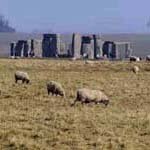Avebury and Stonehenge World Heritage Site Special Project
Region: South West
Owner Type: Many
Funding Body: DEFRA
Year of Intervention: 2002 - 2004
Summary: The Stonehenge and Avebury grass restoration program is a new initiative for the World Heritage Site. Funded by a special Countryside Stewardship Scheme from DEFRA, it is aimed at stopping plough damage on archaeological remains and enhancing the setting of Stonehenge.
Description: The Avebury and Stonehenge landscapes were designated as a World Heritage Site in 1986 because of their unique concentrations of prehistoric monuments. In addition to the well-known ceremonial monuments, such as the Stonehenge and Avebury henge and stone circles, there are many more prehistoric features within this unique landscape. The majority of these are burial mounds. In total there are about 1000 known archaeological sites within the World Heritage Site, both visible and non-visible.
Issue: To help protect such a wealth of features, a Countryside Stewardship Special Project has been developed in partnership between the Department for Environment, Food and Rural Affairs (DEFRA), English Heritage and the National Trust. The enhanced payments offered through this Special Project are only available to landowners and farmers within the World Heritage Site.
Strategy: A special grant for farmers in the Stonehenge and Avebury World Heritage Site is provided by DEFRA for returning arable fields to grass. The rate of œ420 per hectare is 50% higher than the normal rate, to reflect the importance of this project for the long-term conservation of the World Heritage Site (WHS).
This is a key project for the implementation of the WHS Management Plan as it fulfils several of its objectives:
- Improved protection of the archaeological heritage by stopping plough damage of important archaeological sites (Objectives 8, 10 and 16)
- Restoration of the grass setting of Stonehenge (Objective 9)
- Improved ecological value of the World Heritage Site (Objective 12)
- Increased access when the National Trust grassland will be open to the public (Objectives 19 and 20)
- Exemplary partnership between the WHS landowners, DEFRA, English Heritage, the National Trust and English Nature (Objectives 1 and 6)
Outcome: The scheme was set up by DEFRA in January 2002, after two years of preparation, and has been very successful with the farmers. Already at Stonehenge, 3 farmers and the National Trust have signed up to the 10-year scheme. The agreements signed will return about 400 hectares of crops to pasture. This represents 25% of the land currently cultivated (1,556 hectares) in the Stonehenge World Heritage Site. More than 60 prehistoric monuments will benefit from the end of plough damage and from an extended grass setting. The field south of Normanton Down Barrows, the North Kite enclosure, Durrington Down Barrows and Cuckoo field (West of Woodhenge) will be grassed over by the end of 2003. Most of the land immediately south and west of Stonehenge, including the Lesser Cursus, will follow over the next 10 years. A national media launch took place on 15 October 2002 with the Environment Minister. Another success is the agreement of the Ministry of Defence to provide seeds from Salisbury Plain as a ‘gift in nature’, which will help to enhance the ecological value of the World Heritage Site.
Funding has been obtained from English Heritage for field walking - archaeological investigation to look for prehistoric flint - and aerial photography of the area before the land use changes. The WHS Officers for Stonehenge and Avebury supervise this work. Another priority is to lobby DEFRA, who is currently reviewing its Countryside Stewardship Schemes, to ensure that the special grant for the World Heritage Site remains.
Keywords: Grants, Management Plans, Repair, Reconstruction & Restoration
© English Heritage, DEFRA and The National Trust


